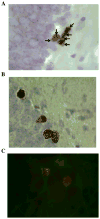Progesterone treatment normalizes the levels of cell proliferation and cell death in the dentate gyrus of the hippocampus after traumatic brain injury
- PMID: 21684276
- PMCID: PMC3153556
- DOI: 10.1016/j.expneurol.2011.05.016
Progesterone treatment normalizes the levels of cell proliferation and cell death in the dentate gyrus of the hippocampus after traumatic brain injury
Abstract
Traumatic brain injury (TBI) increases cell death in the hippocampus and impairs hippocampus-dependent cognition. The hippocampus is also the site of ongoing neurogenesis throughout the lifespan. Progesterone treatment improves behavioral recovery and reduces inflammation, apoptosis, lesion volume, and edema, when given after TBI. The aim of the present study was to determine whether progesterone altered cell proliferation and short-term survival in the dentate gyrus after TBI. Male Sprague-Dawley rats with bilateral contusions of the frontal cortex or sham operations received progesterone or vehicle at 1 and 6 h post-surgery and daily through post-surgery Day 7, and a single injection of bromodeoxyuridine (BrdU) 48 h after injury. Brains were then processed for Ki67 (endogenous marker of cell proliferation), BrdU (short-term cell survival), doublecortin (endogenous marker of immature neurons), and Fluoro-Jade B (marker of degenerating neurons). TBI increased cell proliferation compared to shams and progesterone normalized cell proliferation in injured rats. Progesterone alone increased cell proliferation in intact rats. Interestingly, injury and/or progesterone treatment did not influence short-term cell survival of BrdU-ir cells. All treatments increased the percentage of BrdU-ir cells that were co-labeled with doublecortin (an immature neuronal marker in this case labeling new neurons that survived 5 days), indicating that cell fate is influenced independently by TBI and progesterone treatment. The number of immature neurons that survived 5 days was increased following TBI, but progesterone treatment reduced this effect. Furthermore, TBI increased cell death and progesterone treatment reduced cell death to levels seen in intact rats. Together these findings suggest that progesterone treatment after TBI normalizes the levels of cell proliferation and cell death in the dentate gyrus of the hippocampus.
Copyright © 2011 Elsevier Inc. All rights reserved.
Figures




References
-
- Anderson KJ, Miller KM, Fugaccia I, Scheff SW. Regional distribution of fluoro-jade B staining in the hippocampus following traumatic brain injury. Exp Neurol. 2005;193:125–130. - PubMed
-
- Ariza M, Serra-Grabulosa JM, Junque C, Ramirez B, Mataro M, Poca A, Bargallo N, Sahuquillo J. Hippocampal head atrophy after traumatic brain injury. Neuropsychologia. 2006;44:1956–1961. - PubMed
-
- Barha CK, Barker JM, Brummelte S, Epp JR, Galea LA. Regulation of adult hippocampal neurogenesis in the mammalian brain. In: Pfaff DA, AP, Etgen AM, Fahrbach SE, Rubin RT, editors. Hormones, Brain and Behavior. Academic Press; San Diego: 2009. pp. 2165–2197.
-
- Barha CK, Brummelte S, Lieblich SE, Galea LA. Chronic restraint stress in adolescence differentially influences hypothalamic-pituitary-adrenal axis function and adult hippocampal neurogenesis in male and female rats. Hippocampus 2010 - PubMed
-
- Barha CK, Galea LA. Motherhood alters the cellular response to estrogens in the hippocampus later in life. Neurobiol Aging 2009 - PubMed
Publication types
MeSH terms
Substances
Grants and funding
LinkOut - more resources
Full Text Sources
Other Literature Sources

